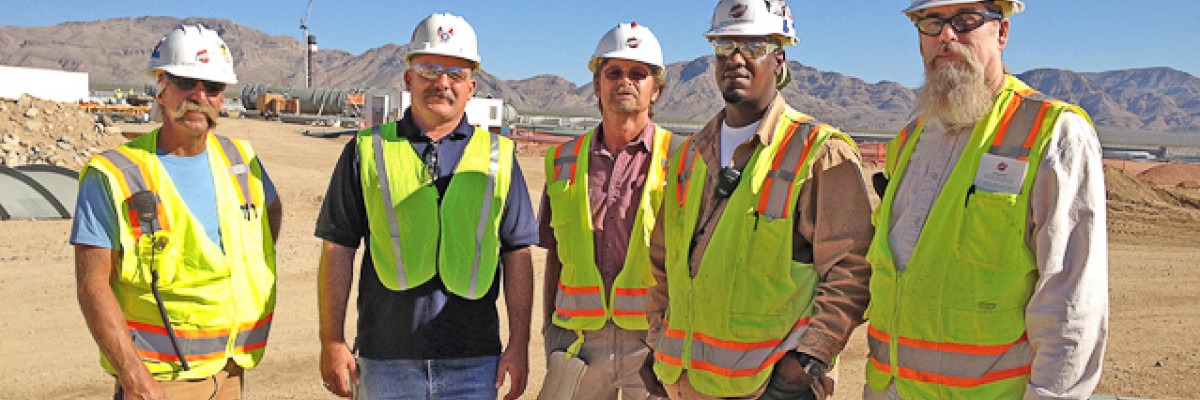Main steward Bob Furnish stands below the unit 1 tower at Ivanpah. The boiler sits atop the tower and is coated with a black, heat-absorbing material. Photo by Chris Farina Photography
View Photo Gallery (7 photos)
L-92 leads critical work at innovative Ivanpah Valley project
RISING FROM THE floor of California’s Mojave Desert, about 40 miles southwest of Las Vegas, the Ivanpah Solar Electric Generating System’s three 459-foot towers resemble missile launch pads. They are the most visible features of a 3,600-acre development that will use focused sunlight to turn water to steam and steam to electricity.
The $2.2 billion, 392-MW project is being built by BrightSource Energy and will provide power to PG&E and Southern California Edison. The U.S. Department of Energy has guaranteed about $1.4 billion for the project.
Boilermakers from Local 92 (Los Angeles) and sister locals, along with other crafts, are building the SEGS under a project labor agreement between Bechtel and the State Building and Construction Trades Council of California and the Building & Construction Trades Council of San Bernardino and Riverside Counties.
Scheduled for completion in 2013, the project, reached the half-way mark this summer, with about 180 Boilermakers and a total of 2,100 craftsmen working at peak manpower.
L-92 BM-ST Mark Thomas explained that each tower supports a boiler with the water tube walls on the exterior — opposite of how boilers are constructed in coal- and oil-fired power plants. This is because the energy source comes from the outside. Concentric circles of mirrors called “heliostats” are being installed to reflect sunlight onto the boiler tube walls, heating them to about 1,000 degrees F. to create superheated steam. The steam will travel to the base of the structure to turn turbines and generate power. About 173,000 10.5-ft. x 7.5-ft. heliostats will be set on pylons and controlled electronically, moving independently for optimum positioning as they track the movement of the sun.
Thomas said Boilermakers are responsible for the boiler work as well as erecting water storage tanks and the air-cooled condenser units that recover water from spent steam. Workers must cope daily with the extreme desert heat, not to mention the potential for a chance encounter with local wildlife.
“Heat exhaustion is a serious safety concern, and our members take the necessary precautions,” Thomas said. “There’s also a risk from rattlesnakes, including the ‘Mojave Green,’ an extremely venomous and aggressive species.”
Concerns about wildlife and habitat have presented challenges for BrightSource as well. Despite being a renewable energy project, Ivanpah has met resistance from environmental groups. The company spent an estimated $2 million for biologists to relocate endangered desert tortoises and will be required to build a fence around the facility to keep wildlife out.
Thomas noted that when completed, the Ivanpah SEGS will provide enough electricity to power about 140,000 homes. The company is also considering building additional solar/thermal projects in the general area.
“Boilermakers have excelled on this project in the face of intense heat, the remoteness of the job site, and environmental delays,” Thomas said. “Our weld acceptance rates through early September have been impressive: 99.5 percent on unit 1 and 100 percent on units 2 and 3.
“I want to especially recognize our main general foreman, Jim Haines; our general foremen on the towers, Gerald Bernard, Lalo Cervantes, Joe Alcorn, and night general foreman Kip John; our general foremen on the air-cooled condensers, Jimmy Holland and Dave Jorgensen; and our main steward, Bob Furnish. These men put their hearts and souls into this project to make the Boilermakers shine.
“Bechtel’s HR manager, Bob Regalado, and supervisors Darrel Rossen and Farran Allen have been exceptional to work with,” Thomas added. He also cited Bechtel night superintendent Charles Snow Jr., a L-363 Boilermaker with 30-plus years of service, for his contributions to the project's success.













